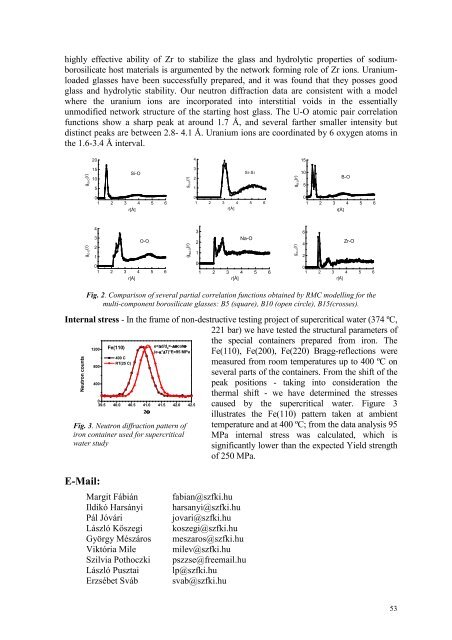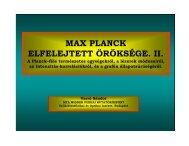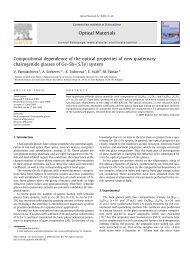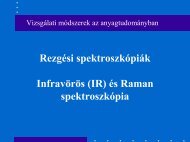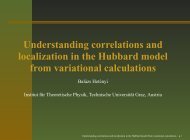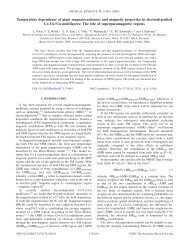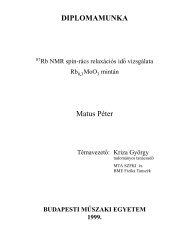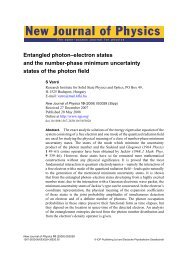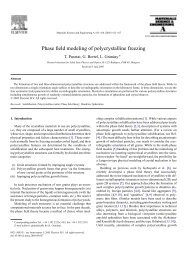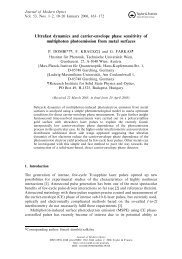ANNUAL REPORT - MTA SzFKI
ANNUAL REPORT - MTA SzFKI
ANNUAL REPORT - MTA SzFKI
Create successful ePaper yourself
Turn your PDF publications into a flip-book with our unique Google optimized e-Paper software.
highly effective ability of Zr to stabilize the glass and hydrolytic properties of sodiumborosilicate<br />
host materials is argumented by the network forming role of Zr ions. Uraniumloaded<br />
glasses have been successfully prepared, and it was found that they posses good<br />
glass and hydrolytic stability. Our neutron diffraction data are consistent with a model<br />
where the uranium ions are incorporated into interstitial voids in the essentially<br />
unmodified network structure of the starting host glass. The U-O atomic pair correlation<br />
functions show a sharp peak at around 1.7 Å, and several farther smaller intensity but<br />
distinct peaks are between 2.8- 4.1 Å. Uranium ions are coordinated by 6 oxygen atoms in<br />
the 1.6-3.4 Å interval.<br />
g Si-O<br />
(r)<br />
20<br />
15<br />
10<br />
5<br />
Si-O<br />
0<br />
1 2 3 4 5 6<br />
r[Å]<br />
g Si-Si<br />
(r)<br />
4<br />
3<br />
2<br />
1<br />
Si-Si<br />
0<br />
1 2 3 4 5 6<br />
r[Å]<br />
g B-O<br />
(r)<br />
15<br />
10<br />
5<br />
B-O<br />
0<br />
1 2 3 4 5 6<br />
r[Å]<br />
g O-O<br />
(r)<br />
4<br />
3<br />
2<br />
1<br />
O-O<br />
0<br />
1 2 3 4 5 6<br />
r[Å]<br />
g Na-O<br />
(r)<br />
3<br />
Na-O<br />
2<br />
1<br />
0<br />
1 2 3 4 5 6<br />
r[Å]<br />
g Zr-O<br />
(r)<br />
6<br />
4<br />
2<br />
Zr-O<br />
0<br />
1 2 3 4 5 6<br />
r[Å]<br />
Fig. 2. Comparison of several partial correlation functions obtained by RMC modelling for the<br />
multi-component borosilicate glasses: B5 (square), B10 (open circle), B15(crosses).<br />
Internal stress - In the frame of non-destructive testing project of supercritical water (374 ºC,<br />
221 bar) we have tested the structural parameters of<br />
Neutron counts<br />
1200<br />
800<br />
400<br />
Fe(110)<br />
400 C<br />
RT(25 C)<br />
e=∆d/d 0 =-∆Θ<br />
∆ΘcotΘ<br />
(e-α*∆T)*E=95 MPa<br />
0<br />
39.5 40.0 40.5 41.0 41.5 42.0 42.5<br />
2Θ<br />
Fig. 3. Neutron diffraction pattern of<br />
iron container used for supercritical<br />
water study<br />
the special containers prepared from iron. The<br />
Fe(110), Fe(200), Fe(220) Bragg-reflections were<br />
measured from room temperatures up to 400 ºC on<br />
several parts of the containers. From the shift of the<br />
peak positions - taking into consideration the<br />
thermal shift - we have determined the stresses<br />
caused by the supercritical water. Figure 3<br />
illustrates the Fe(110) pattern taken at ambient<br />
temperature and at 400 ºC; from the data analysis 95<br />
MPa internal stress was calculated, which is<br />
significantly lower than the expected Yield strength<br />
of 250 MPa.<br />
E-Mail:<br />
Margit Fábián<br />
Ildikó Harsányi<br />
Pál Jóvári<br />
László Kőszegi<br />
György Mészáros<br />
Viktória Mile<br />
Szilvia Pothoczki<br />
László Pusztai<br />
Erzsébet Sváb<br />
fabian@szfki.hu<br />
harsanyi@szfki.hu<br />
jovari@szfki.hu<br />
koszegi@szfki.hu<br />
meszaros@szfki.hu<br />
milev@szfki.hu<br />
pszzse@freemail.hu<br />
lp@szfki.hu<br />
svab@szfki.hu<br />
53


